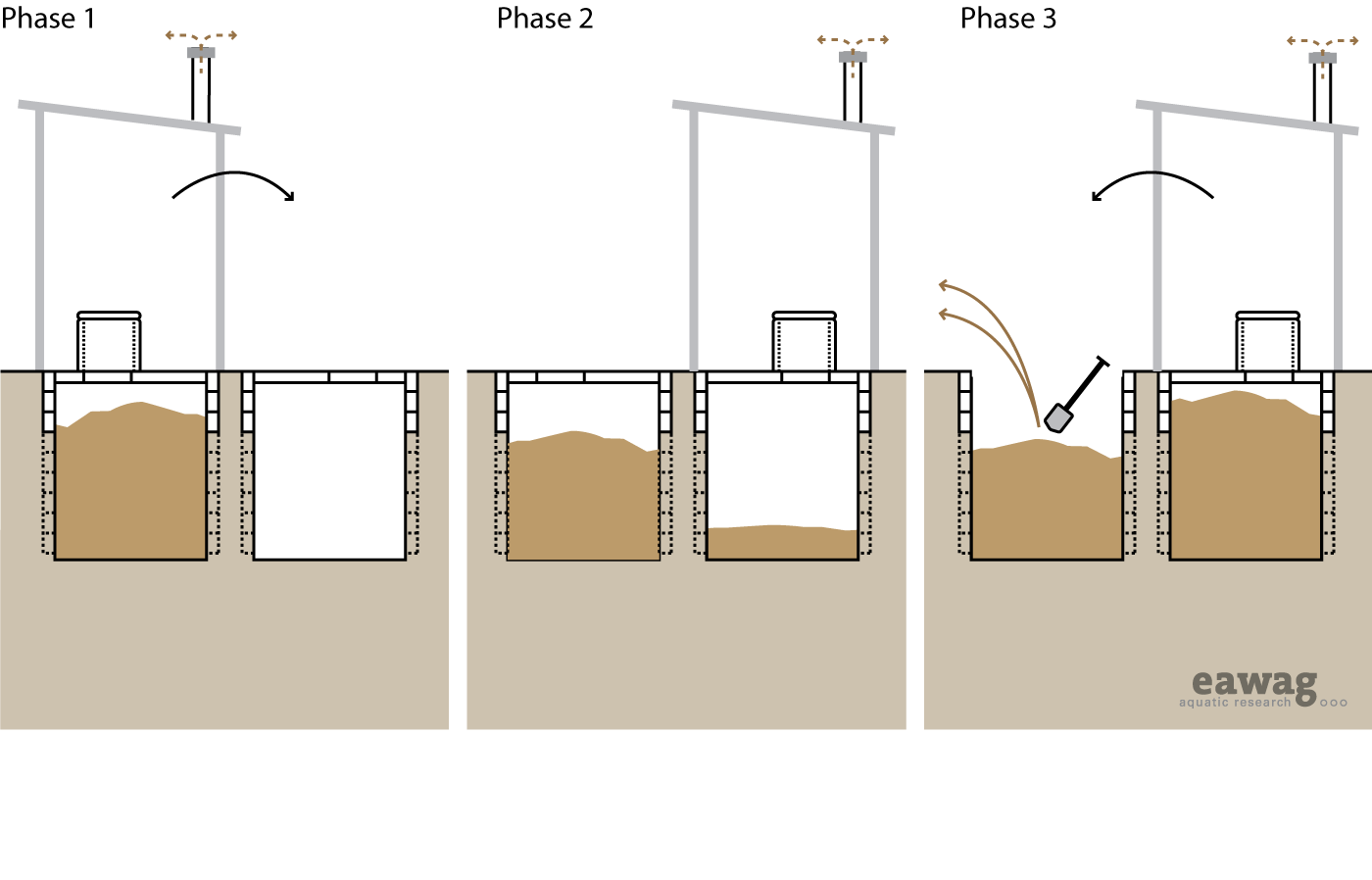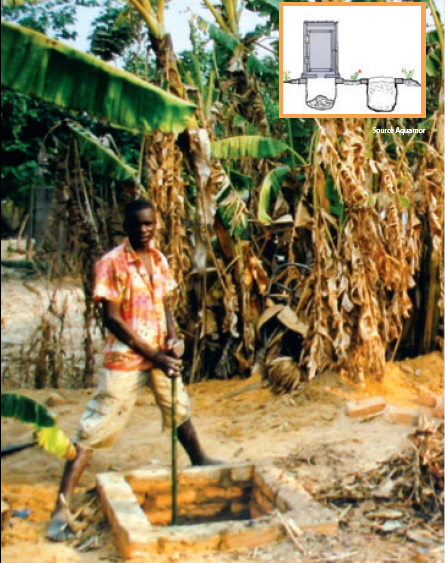Fossa Alterna
|

|
|
| |||||||||||||||||||||||||||||||
The Fossa Alterna is an alternating, waterless (dry) double pit technology. Compared to the Double VIP which is just designed to collect, store and partially treat excreta, the Fossa Alterna is designed to make EcoHumus. The Fossa Alterna is dug to a maximum depth of 1.5 m and requires a constant input of soil.
Two shallow pits are dug next to each other (0.5 1.5 metre deep). One of the Fossa Alterna pits should fill over a period of 12–24 months depending on the size of the pit and the number of users. When a pit is full, the concrete slab and portable superstructure are placed on the second pit. The full pit degrades during the period of time that the second pit is filling, which, ideally, should take one year. The material in the full pit will degrade into a dry, earth-like mixture that can be easily removed manually.

Soil, ash, and/or leaves should be added to the pit after defecation (not urination). The soil and leaves introduce a variety of organisms like worms, fungi and bacteria which help in the degradation process. Also, the pore space is increased, which allows for anaerobic conditions. Additionally, the ash helps to control flies, reduce odours and make the mix slightly more alkaline.
The Fossa Alterna should be used for urine, but water should not be added (small amounts of anal cleansing water can be tolerated). Water encourages the development of vectors and pathogens but it also fills the porespaces and deprives the aerobic bacteria of the oxygen that is required for degradation. The choice of User Interface will determine the material that enters the pit. Since bulking material is used to continuously cover the excreta, smells are reduced but the addition of a ventilation pipe can reduce the smells even further.
The Fossa Alterna pits are relatively shallow with a depth of 1.5m. Even though the pits are shallow, this should be more than enough space to accommodate a family of 6 for one year. To optimize the space, the material that mounds in the centre of the pit (underneath the toilet) should be pushed to the sides periodically. Unlike a simple or ventilated pit which will be covered or emptied, the material in the Fossa Alterna is meant to be reused. Therefore, it is extremely important that no garbage is put into the pit as it will reduce the quality of the material recovered, and may even make it unusable.
After composting, the content of the first pit can be used as fertiliser. The best compost time is more than 12 months. The material can be excavated earlier at 6 months, but is best transferred at this stage to a pit in which a tree will be planted.
Emptying the Fossa Alterna is easier than emptying other pits: the pits are shallower and the addition of soil means that the material is less compact. The material that is removed is not offensive and presents a reduced threat of contamination.
| Advantages | Disadvantages/limitations |
|---|---|
| - Can be built and repaired with locally available materials. - Because double pits are used alternately, their life is virtually unlimited. - Potential for use of stored faecal material as soil conditioner. - Flies and odours are significantly reduced (compared to non-ventilated pits). - Does not require a constant source of water. -Shallow depth of pit required - Suitable for all types of user (sitters, squatters, washers and wipers). - Low (but variable) capital costs depending on materials; no or low operating costs if self-emptied. - Small land area required. - Significant reduction in pathogens. |
- Requires constant source of cover material (soil, ash, leaves, etc.) - Garbage thrown in the pit may ruin reuse opportunities of Compost/EcoHumus. |
Adequacy
The Fossa Alterna is appropriate for rural and peri-urban areas. It is especially adapted to waterscarce environments. It is a useful solution for areas that have poor soil and could benefit from the composted humic material as a soil amendment. A constant source of soil, ash and/or leaves is required.
Not applicable in areas with a high water table, with very loose soil (which could collapse), or very solid soil which would prevent drainage. In order to prevent water tables penetrating the pits and contaminating the water, pits should be shallow. The conversion of excreta into humus will not take place if the pit is flooded with water. Therefore, the pit should not be sealed and water used for anal cleaning should not enter the pit.
The Fossa Alterna is not appropriate for greywater as the pit is shallow and the conditions must remain aerobic for degradation. Another greywater treatment system must be used in parallel. A Urine Diverting Dry Toilet can be used with the Fossa Alterna, but only in circumstances when the soil cannot sufficiently absorb the urine or when urine is highly valued for application.
The material is manually emptied from the Fossa Alterna (it is dug out, not pumped out), so vacuum truck access to the pits is not necessary. The Fossa Alterna technology will only work properly if the two pits are used sequentially and not concurrently. Therefore, an adequate cover for the out of service pit is required. The Fossa Alterna is especially appropriate when water is scarce. It is not suited for rocky or compacted soils (that are difficult to dig) or for areas that flood frequently.
As with many sanitation systems, household members need to understand the key principles for efficient operation and maintenance and discipline is required for adding soil after each defecation.
Health Aspects/Acceptance
By covering faeces with soil/ash, flies and odours are kept to a minimum. Users may not understand the difference between the Fossa Alterna and a Double VIP, although if given the opportunity to use one, people should have a good appreciation of the advantages. Demonstration units can be used to show how easily one can empty a Fossa Alterna in comparison to emptying a Double Pit. Keeping the contents sealed in the pit for the duration of at least one year makes the material safer and easy to handle. The same precautions that are taken when handling compost should be taken with the humus derived from the Fossa Alterna.
Maintenance
When the first pit is put into use, a layer of leaves should be put into the bottom of the pit. Periodically, more leaves should be added to increase the porosity and oxygen availability. Following the addition of faeces to the pit, a small amount of soil or ash should be added. To lengthen the filling time of the pit soil is not added to the pit following urination.
Occasionally, the mounded material beneath the toilet hole should be pushed to the sides of the pit for an even distribution of materials. Depending on the dimensions of the pits, materials should be emptied every year.
Manual
This document contains a lot of information about building, maintaining a fossa alterna.
References
- Elizabeth Tilley et.al (2008). Compendium of Sanitation Systems and Technologies (low res version). Department of Water and Sanitation in Development Countries (Sandec) at the Swiss Federal Institute of Aquatic Science and Technology (Eawag). (Provides a full overview of sanitation systems.)
- Morgan, P. (2007) Toilets That Make Compost: Low-cost, sanitary toilets that produce valuable compost for crops in an African context. Stockholm Environment Institute, Sweden. Available: http://www.ecosanres.org (Step-by-step guide for building a Fossa Alterna.)
